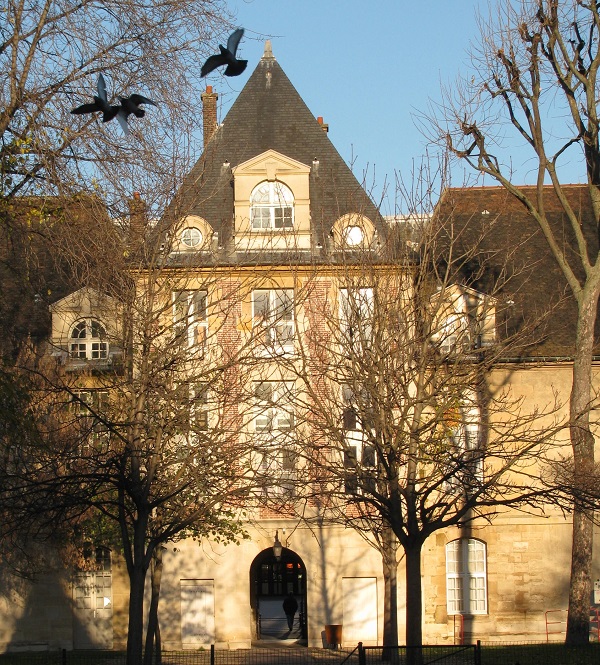
Paris has a rich if sometimes horrific hospital and medical heritage. Hitting the medical trails of the capital allows the off-beat traveler to encounter peaceful courtyards, beautiful chapels, a magnificent crypt, troubling and enlightening history and much medical knowledge along the way.
Hospital visits are worrisome enough back home, so it’s understandable that you’d be wary of visiting a medical facility when abroad. But just as you needn’t be an artist or model to visit the Louvre, you needn’t be a doctor or ill to visit one of the city’s historic hospitals and medical museums.
Paris has a rich if sometimes horrific hospital and medical heritage. While exploring that heritage will be especially noteworthy for travelers in the medical field, it offers any off-beat traveler the opportunity to learn much about the history of health care and medical progress in France, of Paris’s treatment of the poor and destitute, and a good deal about rabies, tumors, anatomical pathologies, mental illness, military medicine, radiation therapy and much more.
Furthermore, several of the hospital courtyards described here are so peaceful that visiting them is in itself a form of therapy to the urban pathologies caused by car fumes, noise and crowds of fellow tourists, beginning with an oasis of calm right next to Notre-Dame Cathedral.

The Hôtel Dieu
Notre-Dame Cathedral receives over 14 million visitors per year but only the rare visitor will venture into the Hôtel Dieu, the hospital right beside it, even though their histories are intimately entwined.
Hôtel Dieu, meaning the house where one is welcomed in the name of God, was founded under the auspices of the Church in the 651 and developed as a place where the Church would receive the ill, the poor and pilgrims. Piety, prayer and medical care, as it were, were united. It was more hospice than hospital, nevertheless in Paris as elsewhere in France, the Hôtel Dieu was (in some cities still is) the heart of the hospital system in the growing city. Expanded and rebuilt over the centuries on the southern (Seine) side of Notre-Dame, Paris’s Hôtel Dieu was eventually moved to the northern side then rebuilt as it’s seen today from 1866 to 1876.
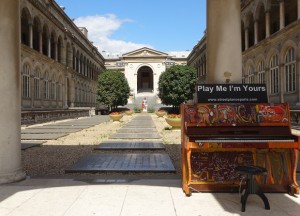 The current hospital complex appears from the outside to be an uninviting block. But enter the sliding doors, turn left with no need to ask permission at the front desk, and you will find yourself in a peaceful, flower-filled courtyard. As a sign that the courtyard may actually be too quiet, too ignored, a piano beneath the gallery at between the courtyard’s two levels begs, in English no less, “Play me I’m yours.”
The current hospital complex appears from the outside to be an uninviting block. But enter the sliding doors, turn left with no need to ask permission at the front desk, and you will find yourself in a peaceful, flower-filled courtyard. As a sign that the courtyard may actually be too quiet, too ignored, a piano beneath the gallery at between the courtyard’s two levels begs, in English no less, “Play me I’m yours.”
This vast hospital complex is currently underused, and the AP-HP, the organization that operates the city’s public hospital system, is in a quandary as to how to reallocate the space. One day there may be busy shops, a crowded café, lodgings or some other financially attractive tourist-pleasing enterprises. Better to come then before the crowds.
The Hôtel Dieu is alongside the square in front of Notre-Dame Cathedral at 1 Parvis Notre-Dame / Place Jean-Paul II, 4th arrondissement. Open daily.
As a public hospital there is no longer an affiliation between the Hôtel Dieu and the Catholic Church, yet the name remains as a reminder of its origin. Similarly, other Paris hospitals have their history written into their names. Les Quinze-Vingts (meaning the fifteen twenties), for example, was founded by (Saint) Louis IX in 1260 to house the poor blind, 300 of them (15×20 according to the base 20 counting system). From its original location on what is now rue Saint Honoré, Les Quinze-Vingts was moved at the end of the 18th century to its current site on rue de Charonne in the 12th arrondissement, where it remains one of France’s foremost ophthalmological institutes.
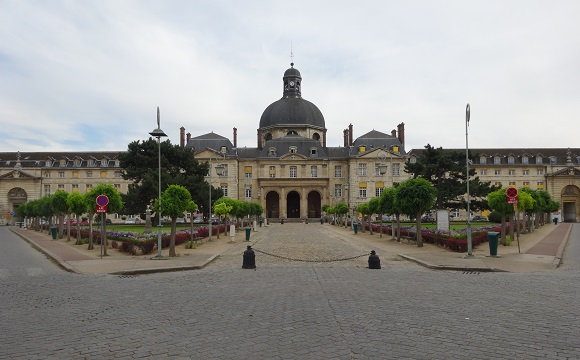
Pitié-Salpêtrière Hospital and the treatment of mental illness
La Salpêtrière has also kept its historic name even though gunpowder (using saltpeter) was only briefly produced on the site centuries ago.
La Salpêtrière was a “general hospital,” which, in the ancien regime, did not mean that it provided medical care but that it housed, often by force, the poor and the indigent. In the name of law and order, Louis XIV’s royal edict of 1656 established institutions “for shutting up poor beggars of the city and suburbs of Paris” who “live almost all in ignorance of Religion, contempt for the Sacraments & in the continual habit of all sorts of vices.”
La Salpêtrière’s most prominent feature is Saint Louis Church (1678), which can be freely visited along with the surrounding courtyard. In 1684 the complex expanded with the addition of a maison de force where, among others, prostitutes and women and girls who couldn’t be controlled by their husband or family were forcibly interned.
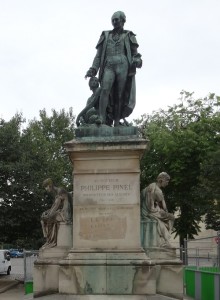
La Salpêtrière may have helped clean up the streets of the capital but it became a sick city unto itself where a mix of beggars, vagabonds, indigents, criminals, the deranged, the “incurably” insane (in many cases chained up for life), the socially disobedient, orphans, the destitute and the aged lived in close proximity, often in ghastly conditions.
In the history of the hospitals and asylums of Paris, La Salpêtrière is above all associated with the incarceration of women and particularly of madwomen (les aliénés). Through them, it is also associated with the evolution of the treatment of mental and neurological disorders (or those diagnosed as such), along with those who sought to improve their living conditions or treat them. A statue by the entrance shows Philippe Pinel (1745-1826), bienfaiteur des aliénés, unchaining a ward of the asylum. Jean-Martin Charcot (1815-1893), a neurologist who used hypnosis among other techniques to attempt understand and to cure “hysteria,” also worked here.
In the early 19th century the notorious “general hospital” was transformed into a civil hospital. La Pitié-Salpêtrière then merged with the adjacent hospital La Pitié in the 1960s, creating the sprawling complex of La Pitié-Salpêtrière, near Gare d’Austerlitz in the 13th arrondissement.
Temporary exhibitions are occasionally presented here, but even without them one can enter within the once-daunting walls of La Salpêtrière is to visit Saint Louis Church and the peaceable courtyard. Fear not, there has been no mental asylum here since 1921.
Hôpital de La Pitié-Salpêtrière. The main entrance to this vast hospital complex is at 83 boulevard de l’Hôpital, 75013, beside the Saint Marcel metro station. However, the historic Salpêtrière portion, including Saint Louis Church, can be entered directly 200 yards downhill at 47 rue de l’Hôpital.
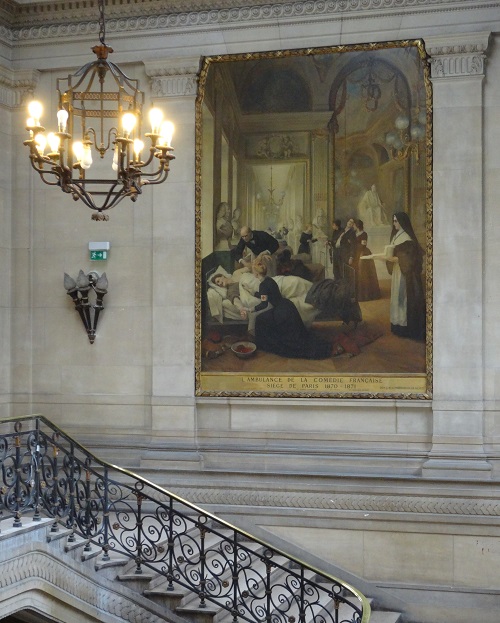
The Museum of the History of Medicine
Even in hospitals more welcoming than the old Salpêtrière it’s difficult to imagine living in a time and place when might have been subjected to the variety of medical tools at the Museum of the History of Medicine, located in the old Faculty of Medicine, now Université Paris Descartes in the 6th arrondissement.
This old-fashion museum, which appears little changed since the room was built in 1905, presents a sweeping view of medical, mostly surgical, progress over the centuries.
Here we can examine medical techniques and technology as practiced through the ages in Paris: scythes for removing gangrened limbs (ponce patients had been knocked out with sponges imbibed with opium or henbane), prosthetics that may have replaced those limbs in the 16th and 17th centuries, 17th– and 18th-century amputation kits, 18th-century surgical kits, 19th-century bladder stone retrieval instruments, the evolution of obstetrical forceps and much more. We learn about the origins of cataract removal in the 1700s.
The museum displays an original wood-and-brass stethoscope that René Laennec invented in Paris in 1816. Previously a doctor would place his ear directly on a patient’s chest to listen to the heart. Laennec worked at Necker Hospital, which was founded in 1778. The hospital’s originality in Paris at the time was that each patient had his or her own bed. In 1802 it was designated as a children’s hospital, the world’s first. Located in the 15th arrondissement, it is still a world-renowned pediatric hospital.
Musée d’Histoire de la Médecine, 12 rue de l’Ecole de Médecine, 6th arrondissement. Metro Odéon. Open 2-5:30pm except Thurs., Sun. and holidays. Entrance: 3€50.
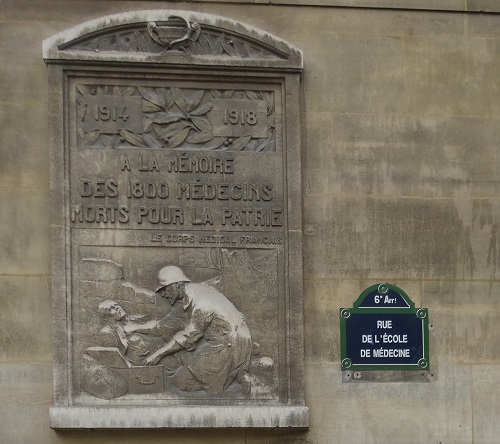
Dupuytren Museum
From the Museum of the History of Medicine, you can cross the street to the Dupuytren Museum, which has existed since 1835 to present examples of anatomical pathologies.
The museum’s display of skeletons, skulls, bones, wax molds, organs in jars, paintings, drawings and photographs is not a pretty sight, but it’s a sight nonetheless, the kind that can either ruin your day or put into perspective the fashion boutiques of the nearby Saint-Germain Quarter. A plaque outside the Cordeliers complex where the museum is located honors the 1800 doctors who “died for France” during the First World War.
Musée Dupuytren, Centre des Cordeliers, 15 rue de l’Ecole de Médecine, 6th arrondisssement. Metro Odéon. Open Mon.-Fri. 2-5pm. Closed late July to early September. Entrance: 5€, 3€ for students and teachers.

Saint Louis Hospital: The Courtyard and the Museum of Molds
Saint Louis Hospital, near Canal Saint Martin in the 10th arrondissement, reveals Paris’s medical and hospital heritage at its most architecturally sublime and at its most infectiously and tumorously horrific.
During the Middle Ages and beyond, periods of plague could be devastating in the dense capital. In 1607 Henri IV fulfilled a desire of the Catholic Order of Augustinians, which administered the Hôtel Dieu, by ordering the construction of a hospital that could be activated during periods of plague. Sainted Louis IX, the hospital’s namesake, had himself died of the plague by the gates of Tunis 1270. The selected site was well beyond the city walls of the time. Contagious patients were further quarantined by being placed within a double walled complex, a feature that makes the central courtyard an exceptional oasis in contemporary Paris.
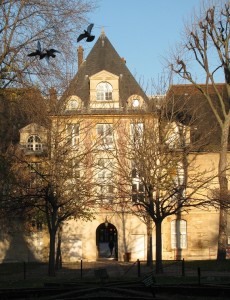
Two years before launching construction of the hospital, Henri IV had ordered the creation of a royal square in the Marais, later called the Place des Vosges. Two of the architects involved in that project, Claude Chastillon and Claude Vellefaux, were also involved in creating the hospital courtyard. Saint Louis therefore echoes the Place des Vosges in its use of brick and stone, but in a sparer, more modest way. Here, patients with contagious disease resided on the second floor.
Created to deal with epidemics, Saint Louis Hospital was used only periodically for its first 165 years of existence. Then a fire that destroyed the Hotel Dieu in 1772 made permanent use of Saint Louis indispensable while the central hospital was being rebuilt. Before long it too was indispensable in the expanding city.
The original buildings of the early 1600s now house administrative offices while patients come to an adjacent complex of buildings as the hospital has been modernized over the past 30 years. Historically specialized in skin diseases, the hospital now also focuses on other specialties as well, including hematology, oncology and organ transplants.
The old buildings meanwhile appear unchanged, except that now there is no sense of imprisonment in the courtyard but rather of security in a secret garden. Such security, in fact, that on weekday afternoon, in the sun or in the shade of the surprising variety of tree species here, this is the preferred playground for neighborhood preschool children, playing on the grass and the gravel paths while a parent or nanny looks on.
Nearby, however, in another part of the hospital complex, it’s another story—and not one for the faint of heart.
The Catacombs of Paris, “the empire of death,” as it says at the entrance, are all the rage for teens and young adults looking for the morbid, giggly thrill of following tunnels lined with millions of bones. But for something truly frightening, Saint Louis’s Musée des Moulages (Museum of Molds, open by appointment and during late-September Heritage Days) is a serious medical house of horrors. It displays wax models of actual tumors, infection and disease, including numerous examples of what has been called “the French disease,” syphilis. Children 12 and under are not allowed in.
Created in 1885 for the purpose of teaching dermatology, the hospital’s historic specialty, the 4807-piece collection is the world’s largest of its kind. The collection and presentation have held Historical Monument status since 1992. One leaves here with a strong will to remain healthy and to wash one’s hand frequently. Here is a glimpse of the museum (commentary in French).
Leaving the museum, some visitors may then want to say a little prayer at the old chapel at the opposite edge of the hospital complex, some may want to return to the courtyard for some leafy contemplation, some may want to flee the hospital complex for a seat in a café by Canal Saint Martin to drink a toast to each other’s health. And we can all rejoice in the discovery of penicillin.
Hôpital Saint Louis – Musée des Moulages. The hospital complex can be entered at 1 avenue Claude Vellefaux or 16 rue de la Grange aux Belles (12 rue de la Grande aux Belles for the chapel), 10th arrondissement. Metro Colonel Fabien or Goncourt, though if visiting the canal area as well you can approach from République. The historic entrance at the end of Avenue Richerand is currently closed for security reasons.
The courtyard of the Hôpital Saint Louis is open weekdays and entrance is free. The chapel is open Mon.-Fri. 2:30-5pm, except for holidays, and Sun. 10:30-12:00am. From late July to late August it is closed except during weekly or twice-weekly mass.
The Museum of Molds (at Porte 14, Secteur Gris) is open by appointment only, Mon.-Fri., 9am-4:30pm, by calling 01 42 49 99 15 or writing to musee.moulages@sls.aphp.fr. Also open during late-September Heritage Days. Visitors must be more than 12 years old. Entrance: 6€ (3€ for students), 7.50€ for visit with presentation in France. Audio-guides available in English for 2€.
Salles de garde: hospital pornography for young doctors
Combine morbidity and sex and you get the salle de garde, the dining room and hang-out for young doctors in their medical residency and other medical staff. At Saint Louis and other public hospitals throughout Paris, salles de garde are normally off-limits to visitors—and it’s probably better that way. Where young doctors may have once dined in refectories surrounded by portraits of the great figures in medicine that preceded them, many now eat among an orgiastic free-for-all of licentious art. This 20th-century tradition, still alive and well, apparently helps keep the stench of death and disease at bay. In fact, among the codes of conduct of the salle de garde is the possibility to “Laugh at everything, at death, at omnipresent suffering, at religion, at patients. To counterbalance misfortune, the salle de garde becomes a place of pleasure and of boisterous pleasure.” The quote is from a document put out by the Public Hospital Administration of Paris. To see what French interns are contemplating when away from their patients, check out the website operated by the Association des Salles de garde (you must be 18 or older to enter the site). For a State-sanctioned illustrated study on the subject see here.
© 2015/2016, Gary Lee Kraut. An earlier version of this article was originally published in the September 2015 issue of the British publication The Connexion.
Continue to Part 2 of Paris Hospitals and Medical Museums

